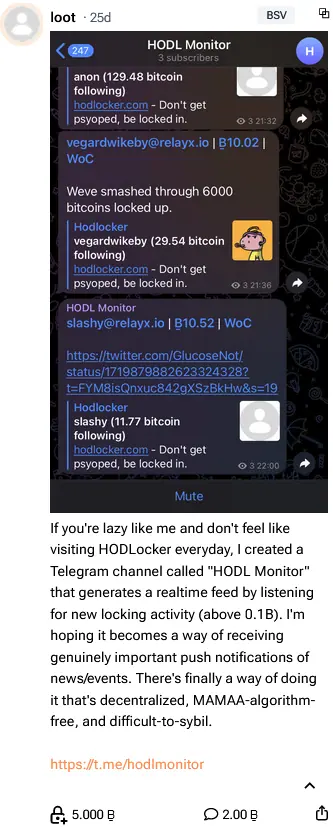|
Getting your Trinity Audio player ready...
|
Pseudonymous developer “Loot” has launched HODL monitor, a Telegram channel where users can digest the latest posts with at least 0.1 BSV locked to them. The idea is for users to receive push notifications and quickly consume locked, on-chain content without necessarily having to visit hodlocker.com or any other interface that supports locking.
Currently, users can use the Trending tab on hodlocker.com, but that is a pull model where users must actively visit the site. HODL monitor is a push model where the data comes to them instead, backed by satoshis. Also, the Trending tab can be abused by spending a small amount of satoshis to temporarily bump a post to the top as it only shows the most recent posts with any amount of locking.

HODL monitor attempts to solve this by implementing a 0.1 BSV minimum threshold, which is better but not ideal. Ideally, users would be able to set custom thresholds for different topics (i.e., hashtags) and follow users instead of receiving the global feed. For example, I could set a threshold of 0.01 BSV for posts containing #music and a 0.2 BSV for posts about #sports.
Loot hopes that the channel is used for important news and events, but this tool can be used for anything at scale. Loot recently posted an update that replies and sublocker support would be added shortly. An example of usage would be for on-chain listings of desired items. If I was interested in a certain NFT collection, I could theoretically configure a service like HODL Monitor for on-chain orders of that collection with at least 0.05 BSV locked and below a certain listing price. Additionally, I could be notified if orders with locking amounts on them sold to stay up to date with market activity. This is all possible as the data is publicly available and contained in the same transaction the locking would reference.
Furthermore, such a service would scale because it only needs to index transactions with locking. In fact, the indexing can be even leaner as it only needs to index transactions with criteria its own users have defined and can prune everything else. This is in contrast to search engines or marketplaces, where they must hold on to lots of valueless data, bloating their databases and hard disks and increasing costs.
With the emergence of a service like HODL Monitor, this increases the incentive and amount to lock in the first place. As Loot states, they are too lazy to check the hodlocker site. Likely, this is the case for other users, too; they do not want to visit the web page, but are happy to receive push notifications or check the Telegram channel. Therefore, users will want to lock against content they perceive to be valuable or want to propagate against whatever coin threshold these services have implemented to ensure as many people see the content as possible. I find myself locking at least 0.1 BSV more often now, so the content is posted to the Telegram channel.
The question becomes, if locked content does indeed optimize information consumption and curation, what is the value of the native commodity used to do so?
Watch: Locking coins and HODLocker with Joshua Henslee

 08-29-2025
08-29-2025 




